 W
WObesity is a medical condition in which excess body fat has accumulated to an extent that it may have a negative effect on health. People are generally considered obese when their body mass index (BMI), a measurement obtained by dividing a person's weight by the square of the person's height—despite known allometric inaccuracies—is over 30 kg/m2; the range 25–30 kg/m2 is defined as overweight. Some East Asian countries use lower values. Obesity is correlated with various diseases and conditions, particularly cardiovascular diseases, type 2 diabetes, obstructive sleep apnea, certain types of cancer, and osteoarthritis. High BMI is a marker of risk, but not proven to be a direct cause, for diseases caused by diet, physical activity, and environmental factors. A reciprocal link has been found between obesity and depression, with obesity increasing the risk of clinical depression and also depression leading to a higher chance of developing obesity.
 W
WAbdominal obesity, also known as central obesity and truncal obesity, is a condition when excessive abdominal fat around the stomach and abdomen has built up to the extent that it is likely to have a negative impact on health. Central obesity has been strongly linked to cardiovascular disease, Alzheimer's disease, and other metabolic and vascular diseases.
 W
WGanesh Acharya is an Indian choreographer, film director and occasional film actor active in India Bollywood. He has choreographed for Bodyguard and Singham amongst others. He has also appeared in numerous music videos for films. He opened out as a film actor with the 2013 dance film ABCD: Any Body Can Dance. He won the National Film Award For Best Choreography at 61st National Film Awards for his work for song "Hawan Kund" from 2013 movie Bhaag Milkha Bhaag. He was also nominated for the Best Choreographer Award for his song "Malhaari" from the 2015 film Bajirao Mastani at 61st Filmfare Awards.
 W
WAdded sugars are sugar carbohydrates added to food and beverages during their production. This type of sugar is chemically indistinguishable from naturally occurring sugars, but the term "added sugar" is used to identify sweetened foods. Medical consensus holds that added sugars contribute little nutritional value to food. This is often expressed colloquially by saying added sugar is "empty calories".
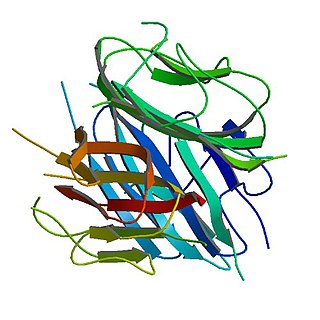 W
WAdiponectin is a protein hormone and adipokine, which is involved in regulating glucose levels as well as fatty acid breakdown. In humans it is encoded by the ADIPOQ gene and it is produced in primarily in adipose tissue, but also in muscle, and even in the brain.
 W
WAdipose tissue, body fat, or simply fat is a loose connective tissue composed mostly of adipocytes. In addition to adipocytes, adipose tissue contains the stromal vascular fraction (SVF) of cells including preadipocytes, fibroblasts, vascular endothelial cells and a variety of immune cells such as adipose tissue macrophages. Adipose tissue is derived from preadipocytes. Its main role is to store energy in the form of lipids, although it also cushions and insulates the body. Far from being hormonally inert, adipose tissue has, in recent years, been recognized as a major endocrine organ, as it produces hormones such as leptin, estrogen, resistin, and cytokine. The two types of adipose tissue are white adipose tissue (WAT), which stores energy, and brown adipose tissue (BAT), which generates body heat. The formation of adipose tissue appears to be controlled in part by the adipose gene. Adipose tissue – more specifically brown adipose tissue – was first identified by the Swiss naturalist Conrad Gessner in 1551.
 W
WAgouti-related protein (AgRP), also called agouti-related peptide, is a neuropeptide produced in the brain by the AgRP/NPY neuron. It is synthesized only in neuropeptide Y (NPY)-containing cell bodies located in the ventromedial part of the arcuate nucleus in the hypothalamus. AgRP is co-expressed with NPY and acts to increase appetite and decrease metabolism and energy expenditure. It is one of the most potent and long-lasting of appetite stimulators. In humans, the agouti-related peptide is encoded by the AGRP gene.
 W
WAndroid fat distribution describes the distribution of human adipose tissue mainly around the buttocks and upper body, in areas such as the abdomen, chest, shoulder and nape of the neck. This pattern may lead to an "apple-shaped" body or central obesity, and is more common in males than in females. Thus, the android fat distribution of men is about 48.6%, which is 10.3% higher than that of premenopausal women. In other cases, an ovoid shape forms which does not differentiate between men and women. Generally during early adulthood, females tend to have a more peripheral fat distribution such that their fat is evenly distributed over their body. However, it has been found that as females age, bear children and approach menopause, this distribution shifts towards the android pattern of fat distribution resulting in a 42.1% increase in android body fat distribution in postmenstrual women. This could potentially provide evolutionary advantages such as lowering a woman's center of gravity making her more stable when carrying offspring.
 W
WThe Atkins diet is a low-carbohydrate fad diet devised by Robert Atkins. The diet is marketed with questionable claims that carbohydrate restriction is crucial to weight loss. There is no good evidence of the diet's effectiveness in achieving durable weight loss and it may increase the risk of heart disease. The Atkins diet is unbalanced as it promotes the unlimited consumption of protein and saturated fat.
 W
WA bariatric ambulance is an ambulance vehicle modified to carry the severely obese. They have extra-wide interiors, and carry "bariatric stretchers" and specialized lifting gear that is capable of carrying very large patients. They are required as a result of the increasing prevalence of obesity in the general population. Currently, there is no standardized weight capacity for bariatric ambulances, and requirements may vary in populations according to epidemiological demand. However, they are typically designed to carry weights between 350 kg and up to at least 450 kg.
 W
WCigarette smoking for weight loss is a weight control method whereby one consumes tobacco, often in the form of cigarettes, to decrease one's appetite. The practice dates to early knowledge of nicotine as an appetite suppressant.
 W
WObesity classification is a ranking of obesity, the medical condition in which excess body fat has accumulated to the extent that it has an adverse effect on health. The World Health Organization (WHO) classifies obesity by body mass index (BMI). BMI is further evaluated in terms of fat distribution via the waist–hip ratio and total cardiovascular risk factors. In children, a healthy weight varies with age and sex, and obesity determination is in relation to a historical normal group.
 W
WComfort food is food that provides a nostalgic or sentimental value to someone, and may be characterized by its high caloric nature, high carbohydrate level, or simple preparation. The nostalgia may be specific to an individual, or it may apply to a specific culture.
 W
WCriticism of fast food includes claims of negative health effects, animal cruelty, cases of worker exploitation, children targeted marketing and claims of cultural degradation via shifts in people's eating patterns away from traditional foods. Fast food chains have come under fire from consumer groups, such as the Center for Science in the Public Interest, a longtime fast food critic over issues such as caloric content, trans fats and portion sizes. Social scientists have highlighted how the prominence of fast food narratives in popular urban legends suggests that modern consumers have an ambivalent relationship with fast food, particularly in relation to children.
 W
WDiet plays an important role in the genesis of obesity. Personal choices, food advertising, social customs and cultural influences, as well as food availability and pricing all play a role in determining what and how much an individual eats.
 W
WThe dietary energy supply is the food available for human consumption, usually expressed in kilocalories or kilojoules per person per day. It gives an overestimate of the total amount of food consumed as it reflects both food consumed and food wasted. It varies markedly between different regions and countries of the world. It has also changed significantly over the 21st century. Dietary energy supply is correlated with the rate of obesity.
 W
WEmpty sella syndrome is the condition when the pituitary gland shrinks or becomes flattened, filling the sella turcica with cerebrospinal fluid instead of the normal pituitary. It can be discovered as part of the diagnostic workup of pituitary disorders, or as an incidental finding when imaging the brain.
 W
WObesity has been observed throughout human history. Many early depictions of the human form in art and sculpture appear obese. However, it was not until the 20th century that obesity became common — so much so that, in 1997, the World Health Organization (WHO) formally recognized obesity as a global epidemic and estimated that the worldwide prevalence of obesity has nearly tripled since 1975. Obesity is defined as having a body mass index (BMI) greater than or equal to 30 kg/m2, and in June 2013 the American Medical Association classified it as a disease.
 W
WWorldwide there has been a large shift towards less physically demanding work and a more sedentary lifestyle. This has been accompanied by increasing use of mechanized transportation, a greater prevalence of labor saving technology in the home, and less active recreational pursuits. At least 31% of the world's population does not get sufficient physical exercise. This is true in almost all developed and developing countries, and among children. Some experts refer to sitting as "the new smoking" because of its negative effects on overall health.
 W
WFatty acid-binding protein 2 (FABP2) also known as Intestinal-type fatty acid-binding protein (I-FABP) is a protein that in humans is encoded by the FABP2 gene.
 W
WThe fat acceptance movement is a social movement seeking to change anti-fat bias in social attitudes by raising awareness among the general public about the obstacles faced by fat people. Areas of contention include the aesthetic, legal, and medical approaches to people whose bodies are fatter than the social norm.
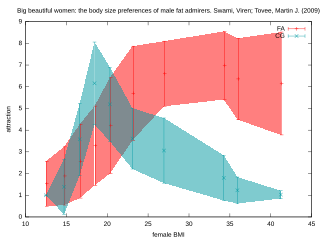 W
WFat fetishism is sexual attraction to overweight or obese people due to their weight and size.
 W
WGastric bypass surgery refers to a technique in which the stomach is divided into a small upper pouch and a much larger lower "remnant" pouch and then the small intestine is rearranged to connect to both. Surgeons have developed several different ways to reconnect the intestine, thus leading to several different gastric bypass procedures (GBP). Any GBP leads to a marked reduction in the functional volume of the stomach, accompanied by an altered physiological and physical response to food.
 W
WLike many other medical conditions, obesity is the result of an interplay between environmental and genetic factors. Studies have identified variants in several genes that may contribute to weight gain and body fat distribution; although, only in a few cases are genes the primary cause of obesity.
 W
WGhrelin is a hormone produced by enteroendocrine cells of the gastrointestinal tract, especially the stomach, and is often called a "hunger hormone" because it increases food intake. Blood levels of ghrelin are highest before meals when hungry, returning to lower levels after mealtimes. Ghrelin may help prepare for food intake by increasing gastric motility and gastric acid secretion.
 W
WGluttony means over-indulgence and over-consumption of food, drink, or wealth items, particularly as status symbols.
 W
WLeblouh is the practice of force-feeding girls from as young as five to nineteen, in countries where obesity was traditionally regarded as desirable. Especially prevalent in rural areas and having its roots in Tuareg tradition, leblouh is practiced to increase chances of marriage in a society where high body volume used to be a sign of wealth. The practice is being done in several African countries, such as Mauritania, Niger, Uganda, Morocco, Sudan, Tunisia, Nigeria, Kenya and South Africa. The synonym gavage comes from the French term for the force-feeding of geese to produce foie gras.
 W
WLeptin is a hormone predominantly made by adipose cells and enterocytes in the small intestine that helps to regulate energy balance by inhibiting hunger, which in turn diminishes fat storage in adipocytes. Leptin acts on cell receptors in the arcuate and ventromedial nuclei, as well as other parts of the hypothalamus and dopaminergic neurons of the ventral tegmental area, consequently mediating feeding.
 W
WA muffin top is a slang term typically used to describe a person's body fat that extends horizontally over the edges of the waistline of tightly fitting pants or skirts, visible when there is a gap between the upper and lower garment. The term is a reference to the way a muffin appears when it has been baked in a muffin tin, so that the top of the muffin extends horizontally over and around the top of the tin or casing.
 W
WNicotinamide phosphoribosyltransferase, formerly known as pre-B-cell colony-enhancing factor 1 (PBEF1) or visfatin for its extracellular form (eNAMPT), is an enzyme that in humans is encoded by the NAMPT gene. The intracellular form of this protein (iNAMPT) is the rate-limiting enzyme in the nicotinamide adenine dinucleotide (NAD+) salvage pathway that converts nicotinamide to nicotinamide mononucleotide (NMN) which is responsible for most of the NAD+ formation in mammals. iNAMPT can also catalyze the synthesis of NMN from phosphoribosyl pyrophosphate (PRPP) when ATP is present. eNAMPT has been reported to be a cytokine (PBEF) that promotes B cell maturation and inhibits neutrophil apoptosis.
 W
WNormal weight obesity is the condition of having normal body weight, but with a high body fat percentage, leading to some of the same health risks as obesity.
 W
WObesity is an important risk factor for many chronic physical and mental illnesses. The generally accepted view is that being overweight causes similar health problems to obesity, but to a lesser degree.
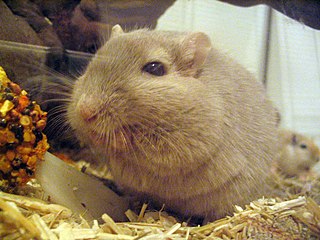 W
WObesity in pets occurs when excessive adipose tissue accumulates in the body, and is generally defined as occurring when an animal's body weight is at least 20% greater than its optimal body weight. Obesity is associated with metabolic and hormonal changes.
 W
WObesogens are foreign chemical compounds that disrupt normal development and balance of lipid metabolism, which in some cases, can lead to obesity. Obesogens may be functionally defined as chemicals that inappropriately alter lipid homeostasis and fat storage, change metabolic setpoints, disrupt energy balance or modify the regulation of appetite and satiety to promote fat accumulation and obesity.
 W
WObestatin is a hormone that is produced in specialized epithelial cells of the stomach and small intestine of several animals including humans. Obestatin was originally identified as an anorectic peptide, but its effect on food intake remains controversial.
 W
WThere are many possible pathophysiological mechanisms involved in the development and maintenance of obesity.
 W
WPeptide YY (PYY) also known as peptide tyrosine tyrosine is a peptide that in humans is encoded by the PYY gene. Peptide YY is a short peptide released from cells in the ileum and colon in response to feeding. In the blood, gut, and other elements of periphery, PYY acts to reduce appetite; similarly, when injected directly into the central nervous system, PYY is also anorexigenic, i.e., it reduces appetite.
 W
WResistin also known as adipose tissue-specific secretory factor (ADSF) or C/EBP-epsilon-regulated myeloid-specific secreted cysteine-rich protein (XCP1) is a cysteine-rich peptide hormone derived from adipose tissue that in humans is encoded by the RETN gene.
 W
WSagittal abdominal diameter (SAD) is a measure of visceral obesity, the amount of fat in the gut region. SAD is the distance from the small of the back to the upper abdomen. SAD may be measured when standing or supine. SAD may be measured at any point from the narrowest point between the last rib and the iliac crests to the midpoint of the iliac crests.
 W
WScreen time is the amount of time spent using a device with a screen such as a smartphone, computer, television, or video game console. The concept is under significant research with related concepts in digital media use and mental health. Studies show that screen time directly impacts child development, and mental and physical health. The positive or negative health effects of screen time are influenced by levels and content of exposure. To prevent harmful exposure to screen time, some governments have placed regulations on its usage.
 W
WA sedentary lifestyle is a type of lifestyle involving little or no physical activity. A person living a sedentary lifestyle is often sitting or lying down while engaged in an activity like reading, socializing, watching television, playing video games, reading or using a mobile phone/computer for much of the day. A sedentary lifestyle can potentially contribute to ill health and many preventable causes of death.
 W
WSleeve gastrectomy is a surgical weight-loss procedure in which the stomach is reduced to about 15% of its original size, by surgical removal of a large portion of the stomach along the greater curvature. The result is a sleeve or tube like structure. The procedure permanently reduces the size of the stomach, although there could be some dilatation of the stomach later on in life. The procedure is generally performed laparoscopically and is irreversible.
 W
WA sugary drink tax, soda tax, or sweetened beverage tax (SBT) is a tax or surcharge designed to reduce consumption of drinks with added sugar. Drinks covered under a soda tax often include carbonated soft drinks, sports drinks and energy drinks. This policy intervention is an effort to decrease obesity and the health impacts related to being overweight, however the medical evidence supporting the benefits of a sugar tax on health is of very low certainty. The tax is a matter of public debate in many countries and beverage producers like Coca-Cola often oppose it. Advocates such as national medical associations and the World Health Organization promote the tax as an example of Pigovian taxation, aimed to discourage unhealthy diets and offset the growing economic costs of obesity.
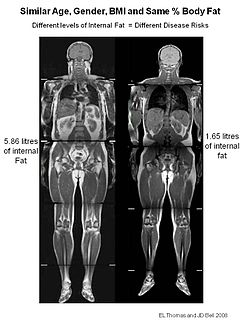 W
WTOFI (thin-outside-fat-inside) is used to describe lean individuals with a disproportionate amount of fat stored in their abdomen. The figure to illustrate this shows two men, both 35 years old, with a BMI of 25 kg/m2. Despite their similar size, the TOFI had 5.86 litres of internal fat, whilst the healthy control had only 1.65 litres.
 W
WTOPS Club, Inc. is a non-profit charitable corporation based in Milwaukee, Wisconsin, United States, having members in chapters located worldwide, the majority of them in the United States and Canada. Its twofold objective is to sponsor research and foster support groups in human body weight control. Most members refer to the organization simply as "TOPS", an acronym for "Take Off Pounds Sensibly."
 W
WManuel Uribe Garza was a Mexican man who suffered from morbid obesity to one of the greatest extents known in recorded history. After reaching a peak weight of around 600 kg (1,300 lb) and having been unable to leave his bed since 2002, he lost approximately 230 kg (510 lb)—over one third of his body weight—with the help of doctors and nutritionists by February 2008. However, he died in his hometown on 26 May 2014 weighing 394 kg (869 lb).
 W
WA very-low-calorie diet (VLCD), also known as semistarvation diet and crash diet, is a type of diet with very or extremely low daily food energy consumption. Often described as a fad diet, it is defined as a diet of 800 kilocalories (3,300 kJ) per day or less. Modern medically supervised VLCDs use total meal replacements, with regulated formulations in Europe and Canada which contain the recommended daily requirements for vitamins, minerals, trace elements, fatty acids, protein and electrolyte balance. Carbohydrates may be entirely absent, or substituted for a portion of the protein; this choice has important metabolic effects. Medically supervised VLCDs have specific therapeutic applications for rapid weight loss, such as in morbid obesity or before a bariatric surgery, using formulated, nutritionally complete liquid meals containing 800 kilocalories or less per day for a maximum of 12 weeks.
 W
WWaistland: The R/evolutionary Science Behind Our Weight and Fitness Crisis is a book by Harvard psychologist Deirdre Barrett published by W. W. Norton & Company in 2007. The book examines the obesity and fitness crisis from an evolutionary standpoint. Barrett argues that our bodies, our metabolisms, and our feeding instincts were designed during human evolution’s hunter-gatherer phase. We’re programmed to forage for sugar and saturated fats because these were once found only in hard-to-come-by fruit and game. Now, these same foods are everywhere—in vending machines, fast food joint, restaurants, grocery stores, and school cafeterias—they’re nearly impossible to avoid. She describes this as related to the focus of another of her books “ supernormal stimuli”—the concept of artificial creations that appeal more to our instincts than the natural objects they mimic—supernormal stimuli for appetite have led to the obesity epidemic. The book opens with a vignette about how zoos post signs saying “Don’t Feed the Animals.” People respect these orders, allowing veterinarians to prescribe just the right balanced diet for the lions, koalas, and snakes. Meanwhile, everyone stops for chips, sodas, and hot dogs on the way out of the zoo. The book explores solutions from behavior modification to willpower to change diet and exercise habits. One of the main messages of the book is that big changes in diet are actually easier than small ones, that the addictive nature of junk food means that, after a few days, eating no cookies or chips is easier than eating fewer cookies or chips.
 W
WWeight gain is an increase in body weight. This can involve an increase in muscle mass, fat deposits, excess fluids such as water or other factors. Weight gain can be a symptom of a serious medical condition.
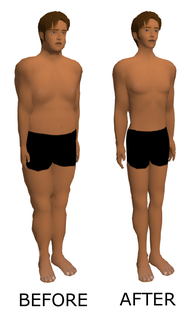 W
WWeight loss, in the context of medicine, health, or physical fitness, refers to a reduction of the total body mass, by a mean loss of fluid, body fat, or lean mass. Weight loss can either occur unintentionally because of malnourishment or an underlying disease, or from a conscious effort to improve an actual or perceived overweight or obese state. "Unexplained" weight loss that is not caused by reduction in calorific intake or exercise is called cachexia and may be a symptom of a serious medical condition. Intentional weight loss is commonly referred to as slimming.
 W
WWorld Fit is a program of the United States Olympic Committee (USOC), and the United States Olympians and Paralympians Association (USOP) to promote physical fitness and the Olympic Games ideals to school children through kids fitness programs, school fitness programs, and childhood obesity programs. World Fit is part of the world's largest obesity-prevention network, EPODE International Network
 W
WWorld Obesity Day is observed globally on 4 March as of March 2020 with the view of promoting practical solutions to end the global obesity crisis. It is organised by the World Obesity Federation, a non-profit body which is in official relations with the World Health Organization and is a collaborating body on the Lancet Commission on Obesity. World Obesity states that its aim is to "lead and drive global efforts to reduce, prevent and treat obesity."